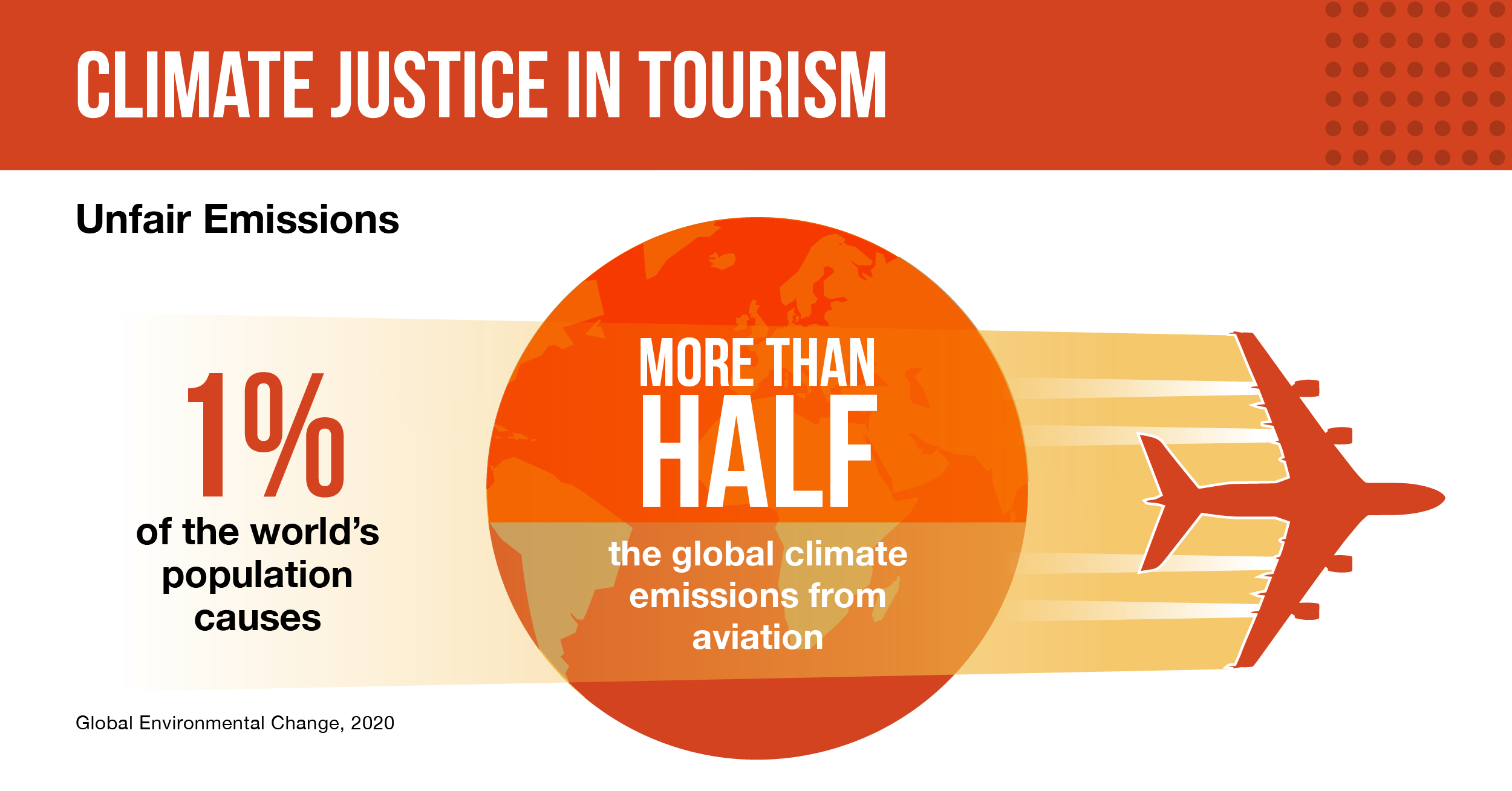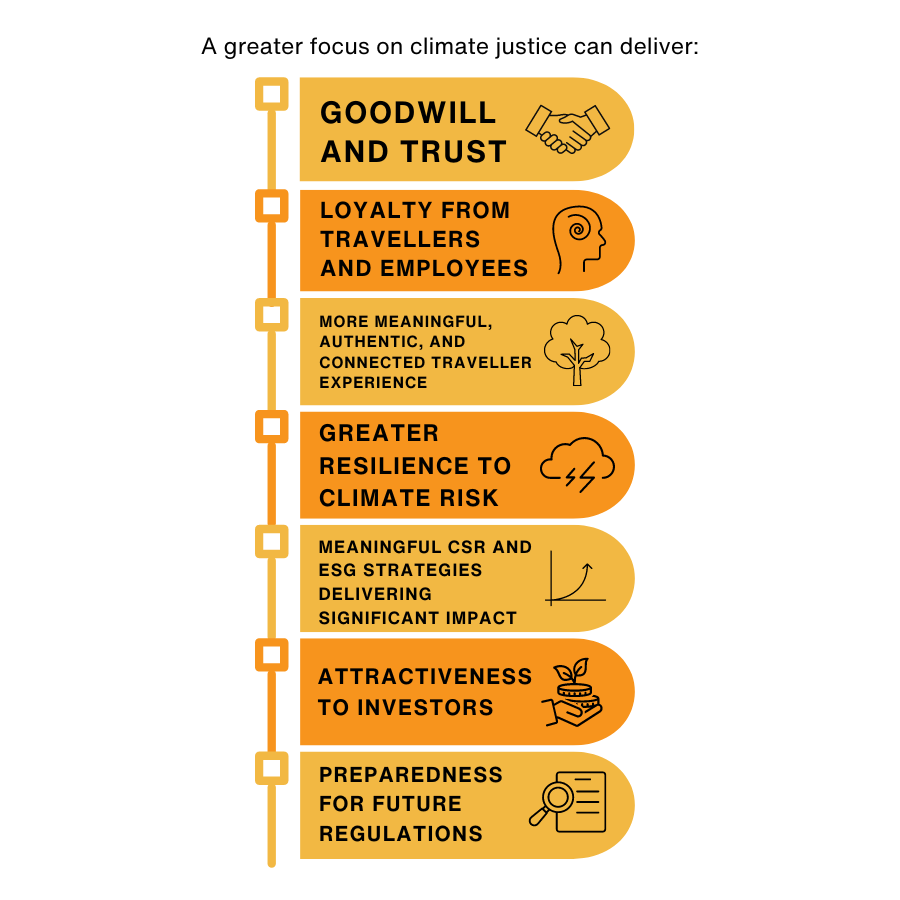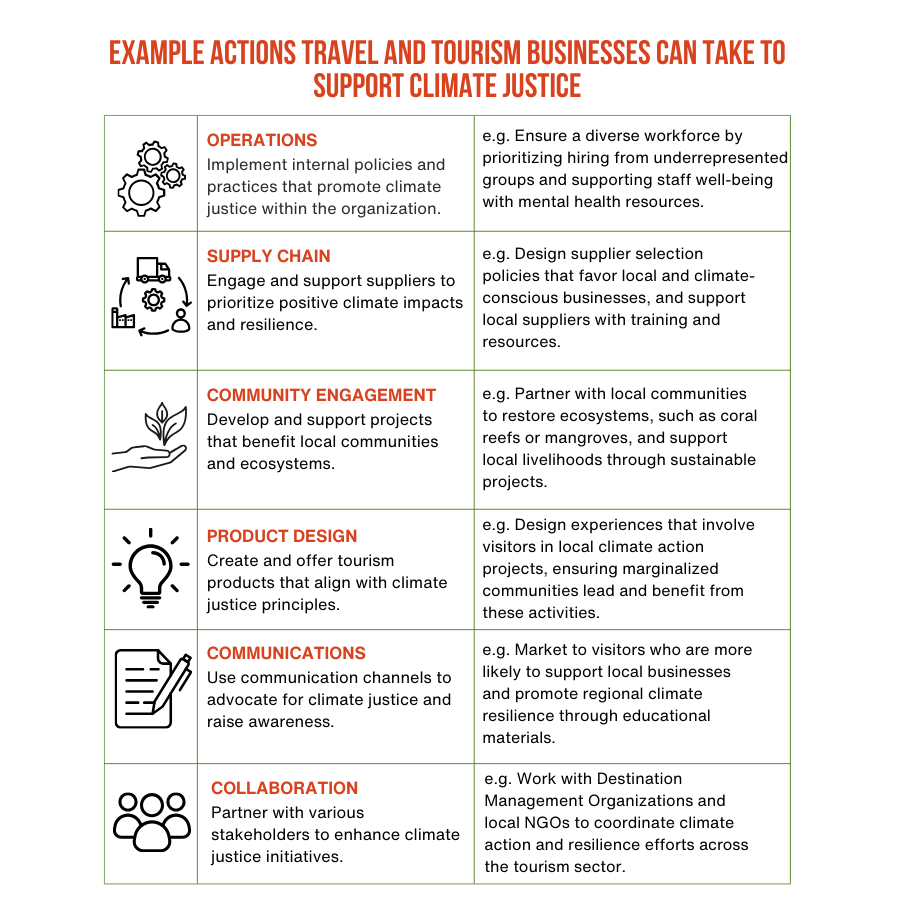Climate justice in tourism

Climate justice
Climate justice is an inclusive approach to climate action that emphasises the leadership and capabilities of affected communities and recognises the unequal responsibility that certain groups (e.g. countries, industries, and businesses) bear in relation to both historical and current greenhouse gas emissions. Just climate action centres on those who are most vulnerable to climate change, and who are often least responsible for causing it.
“When it comes to climate justice, ignorance is no defence. The fact that you don't know doesn't mean you can't find out, just as with laws. The tourism industry must just rise up to the occasion and get themselves informed."
Although climate change is a worldwide crisis, it is not experienced equally or uniformly everywhere. This is why climate justice matters.
Climate justice acknowledges that communities across the Global South are often those most severely impacted by climate change, despite having caused far fewer emissions than those in the Global North. It also recognises that it is most often the communities of the Global South, as well as disadvantaged parts of the Global North, that have the fewest resources with which to adapt to the climate crisis.
Looking through a climate justice lens at travel and tourism reveals how the risks of climate change extend beyond tourism businesses and travellers to threaten the livelihoods and central assets of host communities, both ecological and cultural, upon which tourism also depends.
"Climate action is partial at best if it ignores the unequal impacts and challenges of the climate emergency on supply chains, places and communities – and it may even cause unintentional harms. Aside from clear social, ethical and environmental imperatives, our report highlights the business benefits and significant opportunities for those taking a climate justice approach, as well as the mounting risks of not doing so."
Climate justice issues in tourism

1. Fair action on emissions
Tourism emissions are disproportionately caused by a small percentage of the global population, predominantly in the Global North, that engages in regular international travel. For example, just 1% of the world’s population causes more than half the greenhouse gas emissions from aviation. Greenhouse gas emissions from rich countries are set to continue to rise (not fall sharply as needed) over the coming years.
Yet the impacts from climate change are disproportionately felt by those who travel the least and cause the least emissions. Low-income countries predominantly in the Global South account for less than 1% of total travel and tourism emissions but will suffer the most from climate change.
“The impacts of the climate crisis that aviation contributes to are being suffered or being felt by marginalised, historically and systemically marginalised peoples. Yet there is a very tiny percentage of the world’s population flying.”

2. Fair action on adaptation and resilience
The most vulnerable tourism destinations face interconnected issues: the most extreme impacts from climate change, limited resources available to adapt to these impacts, and a high dependency on tourism.
A reliance on a tourism-based economy can exacerbate climate risks for communities. Tourism is susceptible to increased disruption and rising costs associated with extreme weather, rising seas and resource scarcity, threatening livelihoods and the viability of some destinations.
Tourism may either bolster or erode the capacity and resilience of communities, depending on whether the needs of the industry and tourist visitors are aligned, or in competition, with the needs of residents. For instance, water security will become even more of a concern for communities already struggling to guarantee access to basic resources, and tourism can be part of the problem, or help build knowledge and infrastructure to be part of the solution.
Another concern is that global companies simply push climate action requirements down the supply chain without providing the corresponding resources. This may result in unintended consequences, where global companies move away from locally owned small and medium-sized enterprises (SMEs) in favour of larger companies better able to respond. As tourism businesses increasingly seek to reduce and manage the risks from climate change that they are exposed to, they may disinvest from certain countries, businesses and tourism activities.
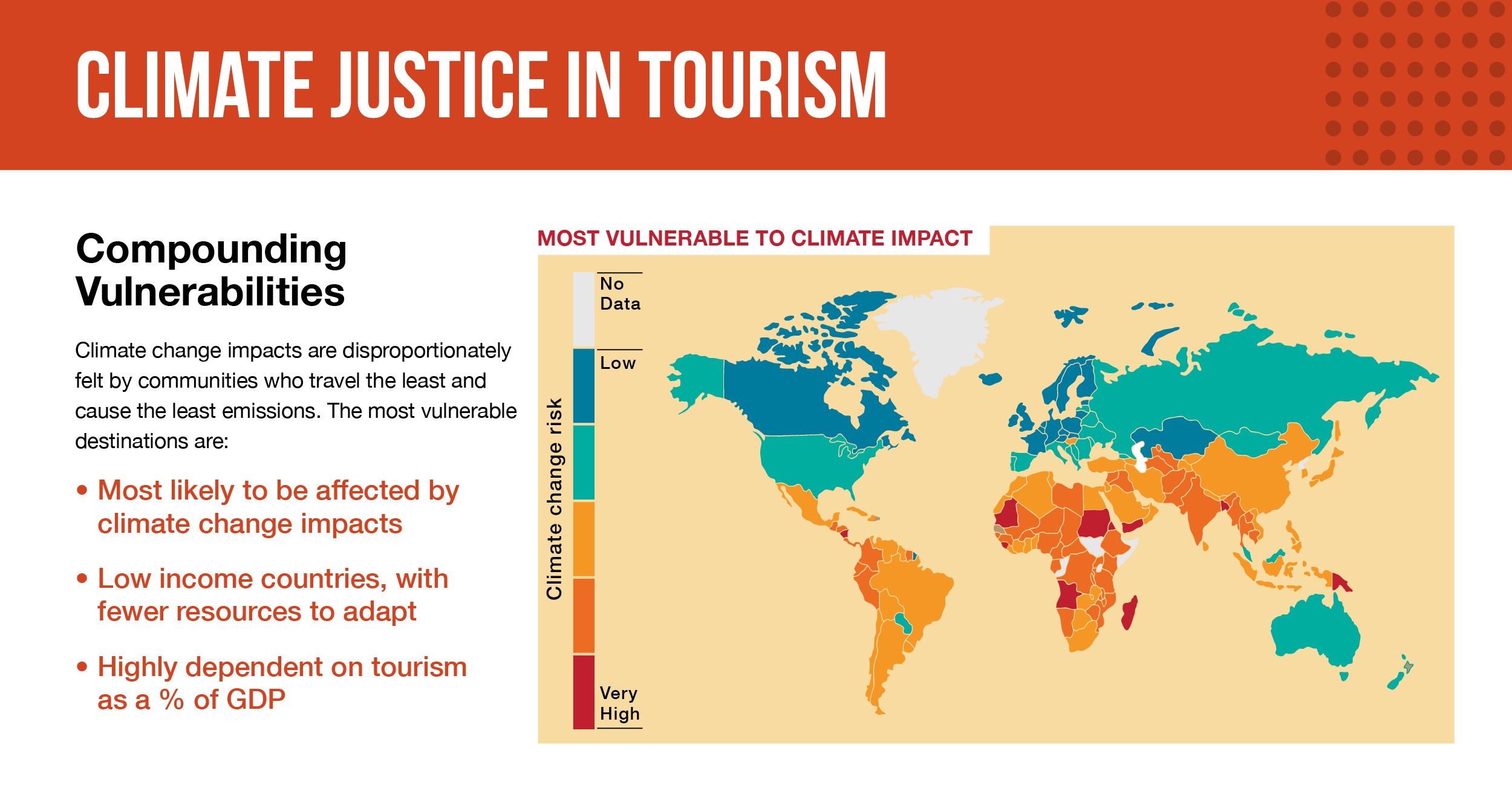

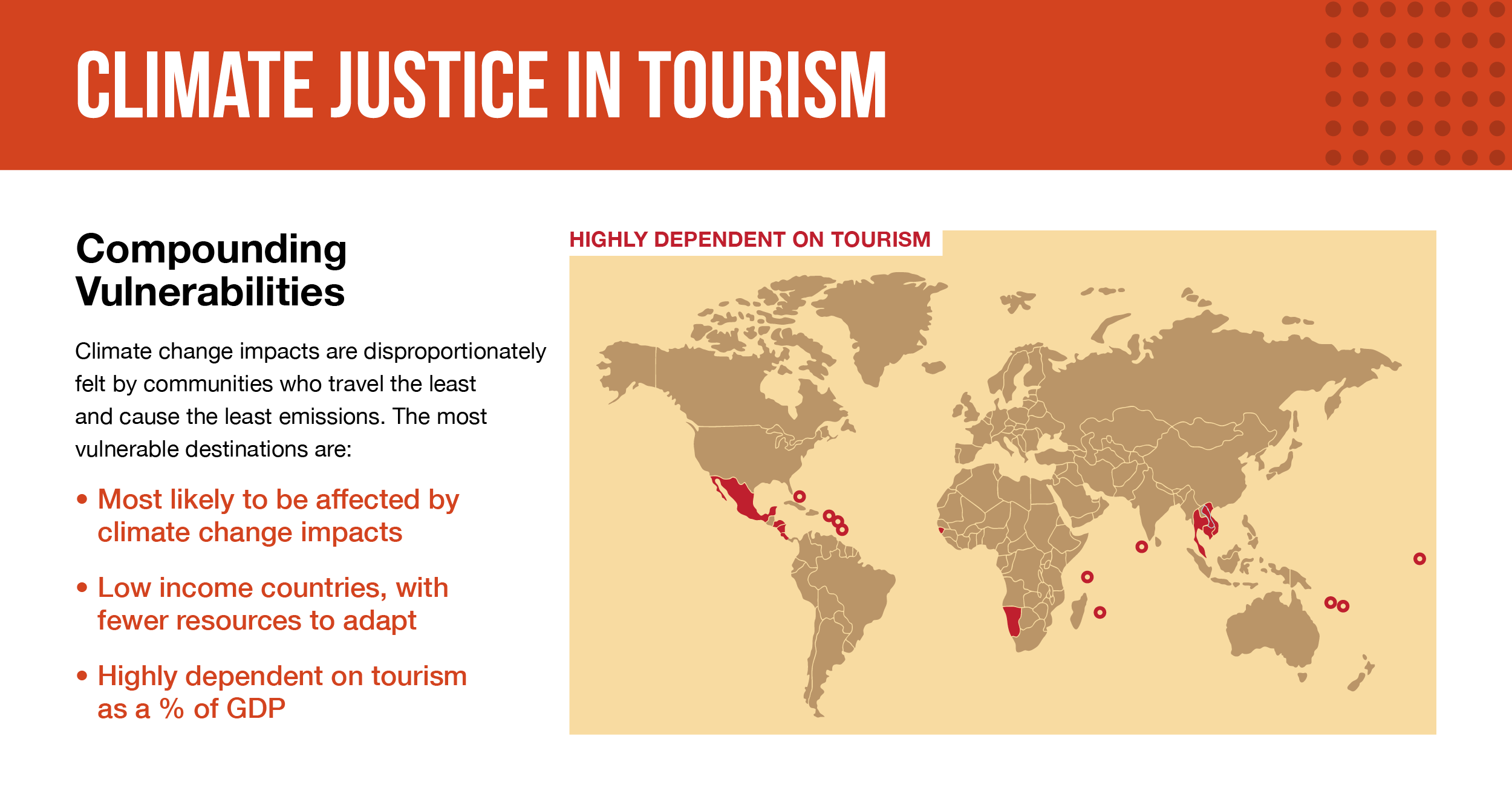



Why should businesses engage in climate justice?

Aside from the social, ethical, and environmental imperatives to act, travel and tourism businesses should also consider the impacts of climate crises on their operations. Companies already incur significant costs associated with addressing climate disruption; these will only increase. Applying principles of climate justice will enable the industry to better position its investments and futureproof its relevance through empowering and centring the communities and ecosystems upon which travel experiences are based.
What is the industry currently doing?

The UN-led Glasgow Declaration for Climate Action in Tourism is the main global climate initiative for travel and tourism businesses and other stakeholders. Its 2024 review of published climate action plans found that:
- Many plans contain actions that might support climate justice, without necessarily being framed that way.
- While many companies focus on the need to address issues around inclusive tourism, few connect it to their work on climate change.
- There is currently little evidence of companies engaging in action to address climate risks to their own business or the communities where they operate.
- There is little evidence in industry plans that the organisation sought the perspectives of communities most closely impacted by climate change during the plan’s creation.
- The plans that show the greatest engagement in climate justice come from those signatories for whom the issue is closest to their direct experience or the reason for their operation. For example, they operate tours run by local Indigenous communities, or operate in fragile mountain ecosystems.
However, overall it is clear that climate justice has not yet been addressed significantly or adequately in the tourism context. Climate justice needs to become an integral and normal part of climate action planning, just as climate action planning needs to become an integral and normal part of business planning.
"In terms of climate justice, it’s hard to be guided in something that you don’t know is relevant to your sector…we probably need to better help the tourism industry understand how relevant climate justice is."
What should the industry do?

The report calls for the tourism sector to:
• Embrace climate justice fully by understanding its implications and integrating it into all areas of operation.
• Collaborate on large-scale initiatives to address climate risks and opportunities for sustainable development.
• Innovate in creating climate-resilient travel products and experiences that are inclusive and equitable.
• Engage diverse voices and forging partnerships across sectors to ensure that climate justice is central to tourism strategies.
• Encourage a holistic approach that considers environmental, social, and economic dimensions to foster sustainable tourism practices.
10 ideas for scaling collaborative action
|
Risk assessments and scenario planning |
Funding mechanisms |
Destination-based collaborative pilots |
Fair regulation and incentives |
Partnerships with DMOs and NTAs |
|---|---|---|---|---|
|
Coordinating climate risk assessments to identify vulnerable communities in business supply chains, and sharing findings to support community resilience. |
A new global climate fund for travel and tourism which could support green transitions and resilience-building in vulnerable destinations. |
Pilot projects focused on critical climate issues in key destinations, to enhance local resilience and reduce dependency on at-risk tourism activities. |
New regulations and incentives that promote sustainable products without disproportionately impacting vulnerable destinations. |
Working with Destination Management Organisations and National Tourism Administrations to connect with local suppliers and NGOs, promoting community-led climate action. |
|
Tourism first responders |
Collaboration to support shared suppliers |
Fair emissions allocation |
Destination resilience index |
Framework for investment and resilience |
|
Collaborating with humanitarian organisations and local leaders to support emergency responses by repurposing hotels, kitchens, resources and logistical expertise. |
Mapping local supply chain linkages and collaborating with competitors on shared supplier activities to streamline climate action requirements and provide enhanced tools and support for local suppliers. |
A carbon budget for international travel and fairly allocating it to host destinations to address disparities in emissions responsibilities. |
Creating a ranking mechanism to identify where tourism supports or undermines community resilience could guide future actions. |
A green taxonomy for investment to direct funds to projects providing social and environmental ROI based on community needs |









